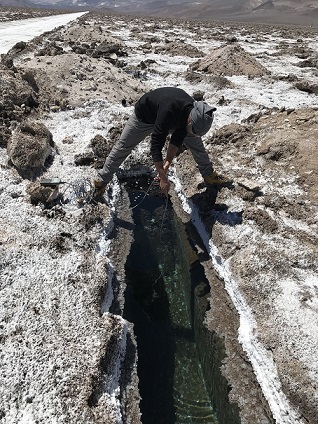That isn't to say Neo Lithium has slowly gone about its work at the 3Q project in Catamarca Province, Argentina - far from it.
The company went from discovery to PEA publication in 22 months and, if its projections for the feasibility study release are correct - scheduled for next year - 3Q will go down as one of the fastest discovery to development stories in the lithium brine space.
The market has evidently not caught up judging by Neo Lithium's valuation.
Marked at a price to net asset value ratio of around 0.1x, the company seriously lags behind the 0.7x P/NAV industry average.
Director and chief operating officer Gabriel Pindar is well aware of this apparent value disconnect, and he and the management team are in the process of doing something about it.
"At the moment, Neo Lithium is a good buy for investors," he told Mining Journal. "3Q is the most recent industry discovery, so we are years behind other companies in terms of marketing."
Now, with a PEA and a number of additional drill hits and processing developments to hand, the team are looking to educate the market.
Tick list
Those being introduced to the story for the first time will likely be surprised by what they find in the corporate presentation.
A May 2017 resource calculation shows 714,242 tonnes of lithium carbonate equivalent (LCE) at an average grade of 716 milligrams per litre in the measured and indicated categories alongside an inferred resource of 1.3 million tonnes LCE at 713mg/litre. These sizeable tonnes come with low, industry-leading levels of impurities such as magnesium and sulphate.
The PEA outlines a 35,000 tonne per annum, 20-year lithium carbonate operation. Good infrastructure and favourable chemistry result in average cash costs of US$2,791 per tonne of carbonate and an upfront capital bill of US$490.2 million.
Factoring in a US$11,760/t average life-of-mine carbonate price estimate - below the current US$14,500/t level quoted by Benchmark Mineral Intelligence - sees the project produce a post-tax net present value (8% discount) of US$1.13 billion.
Yet these numbers are only part of the story.
JP Morgan, BlackRock, M&G and other significant institutional investors on the Neo Lithium register require a bit more than tasty numbers on a spreadsheet.
Pindar puts these firms' early-stage involvement down to the management team's past experience.

Neo Lithium's Gabriel Pindar believes lithium miners are still playing catchup with the battery manufacturers
For, while Neo Lithium might be a new market entrant, its team is far from untested.
President and CEO Waldo Perez was the original founder and past CEO of Lithium Americas (CN:LAC), with chairman Constantine Karayannopoulos previously holding a director post. Lithium Americas owns 50% of the Cauchari-Olaroz project in Argentina and, in partnership with industry leader SQM (US:SQM), is constructing a stage one 25,000tpa carbonate operation.
This followed the publication of a feasibility study that swiftly saw Lithium Americas secure over US$200 million from Asian offtakers to fund its half of the capex bill.
On the process and chemical engineering side, Neo Lithium is littered with industry talent that has worked for both SQM and Orocobre (AU:ORE). The latter has been producing a carbonate product at its own Olaroz project in Argentina for more than three years.
In Pindar, Neo Lithium has an executive that has helped along several sizeable projects in the mining space while at consultancies and big miners. He was instrumental in fast tracking some iron ore developments during the recent China-led steel boom.
That ticks off the fundraising, chemistry and engineering boxes on the investor wish list.
Strategic demand
A ‘boom' is exactly what Neo Lithium and Pindar find themselves in, hence the company's speedy delivery of project milestones.
"When he (Perez) found 3Q, we decided to go really quickly because the market is begging for more product," Pindar said.
The car manufacturers, sensing significant consumer demand for electric vehicles in the medium term on the back of policy changes across the globe, are out for more lithium-ion batteries, while the upstream manufacturers are building EV battery production capacity like never before.
The lithium market, while in expansion mode, is still behind, according to Pindar.
"A couple of years ago, we only had six battery factories and, including the ones in progress, we now have 24," he said.
"You can argue about how much lithium demand is growing on an annual basis, but mine capacity has not yet grown four-fold."
Such a perceived deficit is becoming apparent.
Despite having enough cash (circa-C$61 million) to complete the feasibility study and even start early-stage construction, Neo Lithium has recently carried out a push into Asia and Europe to find strategic investors.
All of them are saying the same thing.

Neo Lithium has delineated some of the highest grade and lowest impurity lithium brine mineralisation during exploration of 3Q
"Every strategic investor we have met is asking for product next year, which puts pressure on us," Pindar said.
Should Neo Lithium hit its goals, it could potentially break ground in 2020 and start producing. That is still some way off, but the company has plenty of near-term goals ahead.
Game-changer
An updated resource estimate is unlikely to change the annual blueprint from the PEA, but should lay out a "very long life 35,000tpa operation", according to Pindar.
That update is due at the end of the September quarter and has been slightly delayed by the discovery of a deep aquifer at the property that has ‘gamechanger' written all over it.
Neo Lithium's first drilling campaign (23 holes) only went down to shallow depths with three holes reaching the basement and the deepest hole being 330m below surface.
When the company returned this year for its second campaign it was armed with the results of a 50-linear kilometre seismic reflection survey - typically used in the oil and gas industry - and drill rigs that could go down to 650m depth.
This led to the discovery of a second body of brine - a deep aquifer - between 400m and 650m depth.
In addition to showing off good grades and low impurities from drilling, the deep aquifer was confirmed as artesian, meaning the lithium brine flows out of the hole without pumping. That is a big plus when it comes to brine extraction but, more important, proves the sediments are productive (i.e. brine will come out of those units).
It also has the potential to significantly boost the resource base and offers rare operational flexibility.
On the latter, Pindar said: "If there is a big storm; something that adds fresh water to the top and dilutes the surface aquifers, we will be able to take brine from depth."
Not many companies have such an option, meaning an unexpected short storm can push production offline for days, if not weeks.
"This is a massive advantage," Pindar said.
Speaking of advantages, the company also recently had a big win on the processing side following brine testing in one of the company's nine test ponds.
The high calcium content of 3Q's brines meant the PEA flowsheet had to include a "conditioning" phase after the first set of pre-concentration ponds where sodium sulphate was added to remove excess calcium before the brine was concentrated again to 6%, in line with SQM's operation in Atacama (very few brines can be concentrated to this high grade, with most concentrate around 1%).
The addition of such a reagent accounted for some US$860/t of the US$2,791/t operating cost.
After reviewing the PEA flowsheet, Neo Lithium's lab technicians devised an alternative whereby, at certain concentrations of lithium, the calcium in the brine could crystallise and precipitate via solar evaporation without a reagent as calcium chloride with six molecules of water.
Under the right conditions, the precipitated crystal holds just calcium and water, meaning the lithium in the brine remains untouched. So far, the company has achieved levels of 3.8% lithuim in brine solution via this route without additives or "conditioning".
Neo Lithium's team, in partnership with consultants Hatch, are working on developing a mechanism where the company can remove the crystals to leave the lithium behind. Pindar said the development should lead to a reduction in both operating and capital costs.
Still on the processing side, the company also has the construction of a pilot lithium carbonate plant to look forward to this year. This will bring back further product data to entice strategic investors onto the Neo Lithium share register.
Such a crowded project schedule and general industry urgency would weigh down a lot of companies, but not Neo Lithium.
The team has sucessfully got a project over the feasibility line once before and is confident it can follow the blueprint again at 3Q.
ABOUT THIS COMPANY
Neo Lithium
HEAD OFFICE:
- 401 Bay Street, Suite 2702, Toronto, Ontario, Canada, M5H 2Y4
- Phone: +1 (416) 962-3300
- Web: www.neolithium.ca
- Email: info@neolithium.ca
DIRECTORS:
- Waldo Perez
- Gabriel Pindar
- Constantine Karayannopoulos
- Thomas Pladsen
- Estanislao Auriemma
QUOTED SHARES ON ISSUE:
- 117.5 million
MARKET CAPITALISATION:
- C$141 million
MAJOR SHAREHOLDERS:
- CATL
- Blackrock
- Mackenzie
- Sprott
- Management



























